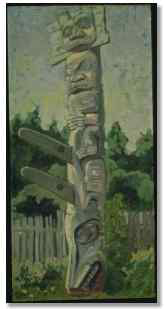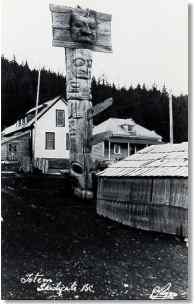Hlradgilda


"The mortuary pole, which the Haida called a xat, meaning'grandfather,' was usually a stout post, hollowed out at the top to receive the grave box of the chief. A front plaque, usually about one metre by two metres, sealed the front of the chamber, and a similar plank formed the roof. The front plaque was always decorated, generally by a crest painting but often combining a separately carved animal face. . . . Less frequently, the support post was also carved."
MacDonald 1983:29
"xat \ 'kät \ n-s Haida
a carved pole erected as a memorial to the dead by some Indians of western No. America"
Webster's Third New International Dictionary, 1961
"This mortuary post, according to Deans (1893:90), was intended for the wife of a Chief Skidegate, who died in December of 1892. However, the woman was interred at her death in the Skidegate cemetery; . . . On the post a human figure holds a two-finned killer whale by the tail. This represents the lazy son-in-law who tears the skin off the wasgo (here shown as the double-finned killer whale) to use as a disguise. On the front plaque is a supernatural snag. All of the crests belonged to the wife."
MacDonald 1983:49
Langdon Kihn's illustrations for the January 1945 issue of the National Geographic Magazine were composites, based on historic photographs and ethnographic descriptions.
These two views*, purporting to depict Haida ceremonies, are based in part on late 19th century photographs of Skidegate village. The framework for the pole raising is modified from an illustration in Barbeau (1929:271).
*No images, pending location of copyright holder(s)
On to T'anuu
See more paintings of Hlragilda
See more photographs of Hlragilda
|

